Rodents and other small mammals may be doing more damage to your food plots than you realize. Here’s how to alleviate the problems.
By Bernie Barringer
When most of us think about the reasons our food plots fail or thrive, we usually point to things like fertilizer, weather, soil types and timing of plantings. But there are factors working behind the scenes that can cause damage to your food plots. Critters large and small use these plots and some of them can cause significant reductions in the productivity of your efforts.
From insects to birds, food plots can be damaged from the moment the seed hits the ground until the usefulness of the forage is complete, but in many cases, small mammals are doing the most damage, and much of it is hard to see from the surface. Let’s take a look at a few of the primary culprits, examine the extent of the damage they do, and explain some actions that can be taken against them.
Pocket Gophers
Damage: Pocket gophers are abundant across much of the whitetail’s range and the mounds they make are a common sight. These mounds cover up small plants which will cause the plants to die. Pocket gophers feed on bulbs, roots and tubers and often consume brassicas from below, without much evidence from above, other than leaves turning brown from lack of moisture. Their tunnels channel needed rain water away from the surface to deep areas where it can’t do the plants much good.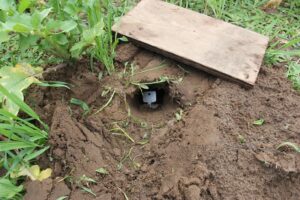
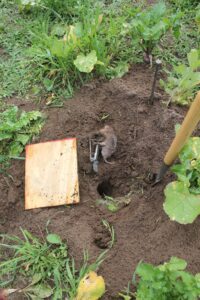
Control: The best way to eliminate pocket gophers is to trap them. Several clutch-style traps have been developed specifically for catching gophers and are available at most any hardware stores or farm stores. I have caught them with several brands and styles of traps, but over time I have switched almost entirely to the EZ Set model. With these traps I have limited misses and most gophers die quickly and humanely in them.
Catching Pocket Gophers is quite easy once you learn where to set the traps. Here in Minnesota, they go to work as soon as the frost goes out of the ground in the spring, and that’s a great time to trap them. I plant brassicas around the first of August and as soon as the plants begin to show up, the pocket gophers arrive and I will once again remove problem individuals.
If you look closely at the gopher mounds, you will see that they form a line of sorts. The gophers pile dirt on the top of the ground as they clear out their tunnels and the mounds form a linear pattern. It stands to reason that the mounds on the end of the line are the most active. If you set a trap at the right mound, you will normally catch the gopher within 24 hours. If you have trouble determining which mounds are the most recent, just put a footprint on each mound and come back the next day. There will be at least one new mound to trap.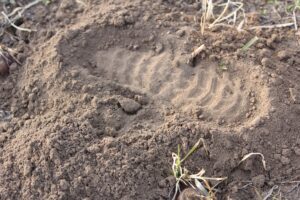
The hole below the mound can be hard to find, but with experience, you can look at the shape of the mound and stick a probe right into the hole. Otherwise, just dig around until you find a soft spot and you will quickly find the associated tunnel. Clear out the tunnel with a small shovel or your hand. Set a trap and slide it inside the entrance to the tunnel. Within a foot of the surface, all tunnels will have a fork in them. Do not push your trap too far into the hole or it may be at the fork which will offer the gophers a chance to crawl right over it.
I stake down my traps not because I think the gopher may get away with my trap, but because a coyote or fox may find it and run off with the gopher and the trap. I like to cover the hole with a board so the tunnel is dark. This keeps predators out and offers the gopher a sense of security so he goes about his business without suspecting a trap.
Gophers are most active at night so check the traps early in the morning so you can dispatch any of the critters that did not quickly die in the traps. You will find that most strings of mounds are the domain of just one gopher, but occasionally you may catch two and even three from the same system of tunnels.
Ground Squirrels
Damage: One of the most common small mammals in the Midwest is the 13-lined ground squirrel. They seem to be everywhere; you’ll see them along roads and in any pasture. They are commonly called stripers or striped gophers, although they are not a member of the gopher family. They dig small holes which lead to underground tunnels where they sleep and store food. These holes are part of the problem they cause. The tunnels drop straight down before turning to the side, and a deer’s lower leg fits right in the tunnel. Deer can sustain serious leg injuries from stepping in one of these holes.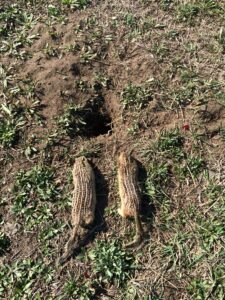
Additionally, the damage these critters cause to food plots comes in the fact that they love the small shoots of plants as they emerge, and these little vermin can kill hundreds of plants a day by nipping them off as soon as they come up. You may ask how much these 1/4-pound buggers can actually eat. The problem is found in the way they fill their overstuffed cheeks with succulent nodules and haul load after load of them back underground to their storage chambers. The damage can be extensive in some areas.
Control: Because these ground squirrels are active during the day, the best way to rid your food plot of them is to shoot them. My sons have enjoyed lying at the edge of the food plot with a scoped .22; the target practice on these little varmints is good preparation for hunting. They have excellent eyesight and will dive underground at the slightest movement. If you want to take a more utilitarian approach, a 12-guage loaded with birdshot will take them out from up to about 50 yards. When hit with a .22 anywhere but in the head, they normally dive in a hole and you don’t know for sure if you have killed them, but when hit with birdshot they are usually lying in a heap right there.
I have to admit I enjoy the challenge of hunting these pests, which adds to the pleasure of knowing I am doing something good for my food plot and my deer herd. This year I invested in a scoped .17 caliber rifle with a bipod and now I spend some warm spring afternoons sprawled out on the grass near my food plots, doing my part to rid the property of these pesky critters. The usual M.O. is to walk out to a food plot and observe where the ground squirrels dive underground when they see me coming. I set up with my crosshairs on the hole and wait patiently. Rarely do I have to wait more than 15 minutes before a little head pops up and mischievously looks around. Bang.
Raccoons, skunks and groundhogs
Damage: The only real food-plot crime committed by groundhogs, often called woodchucks, is they compete with the deer animals for the plants in the food plot. Skunks mess up food plots by digging for grubs and uprooting plants. Raccoons are also guilty of this and they can do some real damage to corn crops. While the amount of damage a family of raccoons may do to a large commercial corn farming operation may be negligible, once they get into the corn in a food plot, their nocturnal raids can cause significant damage.
Raccoons will pull down entire corn stalks and take one or two bites out of the ear of corn to gauge the stage of maturity. They love to eat the corn when it’s in the milk stage and there’s a short window where the bandits do the most damage. But their bites on each ear invite insects that can ruin the entire ear of corn. Plus the fact that the stalk is often broken off when pulled down means it will quickly die 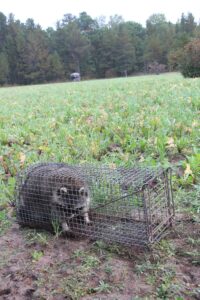 before the corn itself is mature.
before the corn itself is mature.
Additionally, anyone who provides supplemental feed for deer or places piles of grain in front of scouting cameras to take inventory of the deer on their property knows how much raccoons can add to the costs of doing so. Raccoons are prolific and are common carriers of distemper and rabies so keeping their population at a manageable level is always a good idea.
Control: I don’t get too excited about removing groundhogs from my food plots because their damage is not significant unless the population gets out of hand. Still when opportunities arise to reduce their population, I do so just as I do the ground squirrels, by shooting them.
I primarily control raccoons during the fall trapping season when their pelts have some value. I hit my property pretty heavy with traps and snares for a couple weeks each fall to reduce their numbers. Outside of the trapping season, when I find that a skunk or raccoon is tearing up my food plot, I simply put out a box trap with something really good smelling in the back corner of it. This may surprise you, but a coon is a real sucker for a half-slice of bacon. Put the bacon in the back of the trap in a position where they can’t reach it with their dexterous front feet to pull it through the wire. Make them walk into the trap to get to the bait and they will oblige.
What to do with the problem animal once you have trapped it can be a dilemma. Many states prohibit the killing of raccoons and skunks outside of the trapping season. Some states offer permits for doing so but some require you to relocate the critter—give your problem to someone else—so make sure you check your state and local game laws so you don’t get yourself in trouble with the law.
If it’s legal to dispatch the problem animal, a shot to the noggin with a .22 takes care of it quickly and humanely. A syringe filled with poison mounted to the end of a broomstick then jabbed into their chest will put them down quickly as well, and is the only way I have found to consistently kill a skunk without it spraying.
While our food plots are intended to benefit deer, other critters benefit as well. Wholesale killing of all other animals using the plot is not the objective, but some diligence in reducing the population of food plot pests is an honorable goal. These simple tips should help you do so, with the added benefit of getting you out to enjoy the property during all times of the year.
The Problem with Poison
It might seem that putting out some poison might be the best way to deal with problem critters. Just place it and forget it; no more intrusion, no dealing with a carcass and a lot less effort. The danger in this approach comes with the fact that poison is indiscriminate. While it may kill a gopher or ground squirrel, it will also kill any other mammal that eats it, and many birds are susceptible to dying from poisons. Some kinds of poisons can be cumulative in the systems of animals. While a fox or bobcat may eat a mouse that dies from poisoning with little adverse affect, if the predator eats several poisoned mice over time, the poison may build up in its system and kill it.
Some states have strict regulations regarding the use of poisons for mammals. While there may be limited applications for poisons in removing problem animals, most of the time it is safer—and more likely to be legal—to shoot and trap the problem individuals. It makes sense to remove the specific problem critter rather than endanger others, some of which may be beneficial.
